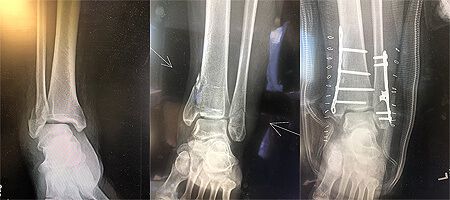October 2018
Ankle Fractures in a Nutshell
 If you have experienced a breaking of any of the bones that make up the ankle joint, which is referred to as an ankle fracture, you may be aware that there can be significant pain as well. The bones that make up the ankle joint are the tibia, fibula, and talus bones. There are many reasons an ankle injury can occur, such as twisting your ankle inwards or outwards, falling, a crush injury, or a motor vehicle accident. An ankle fracture can also occur due to sports injury, repetitive stress, or as a consequence to nerve problems of the feet and legs.
If you have experienced a breaking of any of the bones that make up the ankle joint, which is referred to as an ankle fracture, you may be aware that there can be significant pain as well. The bones that make up the ankle joint are the tibia, fibula, and talus bones. There are many reasons an ankle injury can occur, such as twisting your ankle inwards or outwards, falling, a crush injury, or a motor vehicle accident. An ankle fracture can also occur due to sports injury, repetitive stress, or as a consequence to nerve problems of the feet and legs.
The symptoms of a broken ankle are pain, swelling, bruising, numbness, throbbing, and difficulty putting weight down on the foot. In more severe cases, there may be a deformity, which may represent a dislocation where the foot can actually separate from the ankle. If you have had an ankle injury, it is important that you consult with your podiatric surgeon so you can start the best course of treatment immediately. If you have any concerns regarding you ankle, contact Dr. Lee R. Stein from Lake Shore Foot & Ankle. Our doctor will treat your foot and ankle needs
Ankle fractures are usually diagnosed with a proper history, as well as x-rays. For proper evaluation, it may be necessary for the doctor to order a CT or MRI scan.
A broken ankle can lead to complications and can occasionally cause long standing deformity or severe pain if not treated properly. In certain cases, a splint, cast, or boot may be the preferred treatment, along with rest, ice, and elevation depending on the fracture type. In other cases, surgery may be necessary, which may involve open reduction internal fixation (ORIF) with screws and/or plate hardware or the use of external fixation (frame around skin). At LSFA we use the latest in biologic techniques to achieve efficient healing with amniotic tissue, bone marrow aspirate, bone stimulation, shockwave, and laser.
By Lee R. Stein, DPM, FACFAS, FACLES, FAENS
Causes of a Broken Toe
 If you have experienced breaking your toe, which is also referred to as a fractured toe, you may be aware of the severe pain that is often associated with it. There may be several reasons why this type of injury may occur. These may include dropping a heavy object on your toe, stubbing it against a piece of furniture, or being involved in an accident in which your feet are affected. There are noticeable symptoms that are indicative of a broken toe, including bruising, swelling, the inability to walk on it, accompanied by pain and discomfort. Treatment options may include keeping the foot raised, which may aid in reducing any swelling, taping the injured toe to the toe next to it to promote stability, in addition to wearing shoes that have adequate room for the toe. If you feel you have broken your toe, it’s advised to counsel with a podiatrist so the best course of treatment can begin.
If you have experienced breaking your toe, which is also referred to as a fractured toe, you may be aware of the severe pain that is often associated with it. There may be several reasons why this type of injury may occur. These may include dropping a heavy object on your toe, stubbing it against a piece of furniture, or being involved in an accident in which your feet are affected. There are noticeable symptoms that are indicative of a broken toe, including bruising, swelling, the inability to walk on it, accompanied by pain and discomfort. Treatment options may include keeping the foot raised, which may aid in reducing any swelling, taping the injured toe to the toe next to it to promote stability, in addition to wearing shoes that have adequate room for the toe. If you feel you have broken your toe, it’s advised to counsel with a podiatrist so the best course of treatment can begin.
A broken toe can be very painful and lead to complications if not properly fixed. If you have any concerns about your feet, contact Dr. Lee R. Stein from Lake Shore Foot & Ankle, PC. Our doctor will treat your foot and ankle needs.
What to Know About a Broken Toe
Although most people try to avoid foot trauma such as banging, stubbing, or dropping heavy objects on their feet, the unfortunate fact is that it is a common occurrence. Given the fact that toes are positioned in front of the feet, they typically sustain the brunt of such trauma. When trauma occurs to a toe, the result can be a painful break (fracture).
Symptoms of a Broken Toe
- Throbbing pain
- Swelling
- Bruising on the skin and toenail
- The inability to move the toe
- Toe appears crooked or disfigured
- Tingling or numbness in the toe
Generally, it is best to stay off of the injured toe with the affected foot elevated.
Severe toe fractures may be treated with a splint, cast, and in some cases, minor surgery. Due to its position and the pressure it endures with daily activity, future complications can occur if the big toe is not properly treated.
If you have any questions please feel free to contact one of our offices located in Chicago, Highland Park, and Uptown, IL . We offer the newest diagnostic and treatment technologies for all your foot and ankle needs.
What to Know About a Broken Toe
Trauma to the foot, especially the toes, can occur in many ways. Banging them, stubbing them, or dropping something on them are a few different ways this trauma can occur. Given the fact that toes are positioned in front of the feet, they typically sustain the brunt of such trauma. When trauma occurs to a toe, the result can be a painful break or fracture. Another type of trauma that can break a toe is repeated activity that places stress on the toe for prolonged periods of time.
Broken toes can be categorized as either minor or severe fractures. Symptoms of minor toe fractures include throbbing pain, swelling, bruising on the skin and toenail, and the inability to move the toe with ease. Severe toe fractures require medical attention and are indicated when the broken toe appears crooked or disfigured, when there is tingling or numbness in the toe, or when there is an open, bleeding wound present on the toe.
Generally, a minor toe break will heal without long-term complications. However, it is important to discontinue activities that put pressure on the toe. It is best to stay off of the injured toe and immediately get a splint or cast to prevent any more additional movement of the toe bones. You can also immobilize your toe by placing a small cotton ball between the injured toe and the toe beside it. Then, tape the two toes together with medical tape. Swelling can be alleviated by placing an ice pack on the broken toe directly as well as elevating your feet above your head.
Severe toe fractures may be treated with a splint, cast, and in some cases, minor surgery, especially when the big toe has been broken. Due to its position and the pressure the big toe endures with daily activity, future complications can occur if it is not properly treated. Pain associated with minor toe fractures can be managed with over-the-counter pain medications. Prescription pain killers may be necessary for severe toe fractures.
The healing time for a broken toe is approximately four to six weeks. In severe cases where the toe becomes infected or requires surgery, healing time can take up to eight weeks or more. While complications associated with a broken toe are immediately apparent, it is important to note that there are rare cases when additional complications, such as osteoarthritis, can develop over time. You should immediately speak with your podiatrist if you think you have broken your toe due to trauma. They will be able to diagnose the injury and recommend the appropriate treatment options.
Blog Archives
- May 2025
- April 2025
- March 2025
- February 2025
- January 2025
- December 2024
- November 2024
- October 2024
- September 2024
- August 2024
- July 2024
- June 2024
- May 2024
- April 2024
- March 2024
- February 2024
- January 2024
- December 2023
- November 2023
- October 2023
- September 2023
- August 2023
- July 2023
- June 2023
- May 2023
- April 2023
- March 2023
- February 2023
- January 2023
- December 2022
- November 2022
- October 2022
- September 2022
- August 2022
- July 2022
- June 2022
- May 2022
- April 2022
- March 2022
- February 2022
- January 2022
- December 2021
- November 2021
- October 2021
- September 2021
- August 2021
- July 2021
- June 2021
- May 2021
- April 2021
- March 2021
- February 2021
- January 2021
- December 2020
- November 2020
- October 2020
- September 2020
- August 2020
- July 2020
- June 2020
- May 2020
- April 2020
- March 2020
- February 2020
- January 2020
- December 2019
- November 2019
- October 2019
- September 2019
- August 2019
- July 2019
- June 2019
- May 2019
- April 2019
- March 2019
- February 2019
- January 2019
- December 2018
- November 2018
- October 2018
- September 2018
- August 2018
- July 2018








